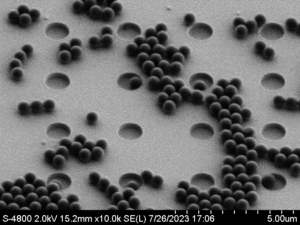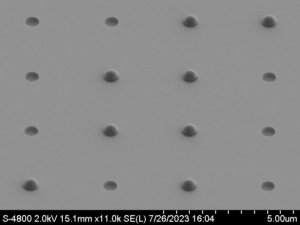Detection Chip Revolutionises Plastic Pollution Monitoring
15 Sep, 2025
A groundbreaking technology developed by an international research collaboration is set to transform how the world detects and monitors nanoplastics – one of the most urgent and insidious forms of pollution threatening our health and environment.
Published in Nature Photonics, researchers from the University of Melbourne and the University of Stuttgart, in collaboration with the ARC Centre of Excellence for Transformative Meta-Optical Systems (TMOS), have unveiled a novel optical sieve capable of cost-effectively detecting, classifying, and counting nanoplastic particles.
Why nanoplastics matter
While the dangers of microplastics are already well established, nanoplastics – even smaller fragments – pose a far greater risk. They infiltrate food, water, and even human organs, crossing biological barriers such as the blood–brain barrier and persisting in tissues for decades. Yet, until now, detecting them has been expensive, complex, and largely restricted to specialised laboratories.
The optical sieve innovation
Led in Australia by Dr Lukas Wesemann (University of Melbourne), the research team created a microchip made from gallium arsenide containing an array of microscopic cavities. When a liquid containing nanoplastics flows across the chip, particles are trapped in cavities matching their size – some as small as 200 nanometres in diameter.

These trapped particles reveal themselves through distinct colour changes in reflected light. Remarkably, this process requires only a standard optical microscope and a basic camera, making it accessible, portable, and affordable.
“This innovation finally gives us the ability to reveal the true scale of nanoplastic pollution outside specialised labs,” said Dr Wesemann. “It opens the door to widespread, scalable monitoring of this critical global challenge.”
Beyond the lab
Associate Professor Brad Clarke (University of Melbourne) highlighted the significance of this breakthrough:
“By making nanoplastic monitoring affordable and mobile, we can begin to truly assess their impact on health, aquatic systems, and soils. This technology is a step forward in protecting ecosystems and people.”
Unlike existing methods, such as dynamic light scattering, the optical sieve does not require plastics to be separated from surrounding biological matter. Initial validation with lake water has shown promise, and future research will expand testing into even more complex environments – including the possibility of analysing blood samples.
TMOS and transformative impact
This work embodies the TMOS mission: pioneering next-generation meta-optical systems that address global challenges. By harnessing nanophotonics and meta-optics to develop real-world solutions, TMOS researchers are creating tools that can safeguard health and the environment.
 With further development, the team is exploring pathways to scale this technology into commercially available environmental testing kits. Such devices could one day be used worldwide to monitor water sources, food supplies, and even human health, transforming how we confront plastic pollution.
With further development, the team is exploring pathways to scale this technology into commercially available environmental testing kits. Such devices could one day be used worldwide to monitor water sources, food supplies, and even human health, transforming how we confront plastic pollution.
This research was supported by the Australian Research Council, the European Research Council, the Australia–Germany Joint Research Cooperation Scheme (Universities Australia-DAAD), the University of Stuttgart, and the University of Melbourne.
Detection Chip Revolutionises Plastic Pollution Monitoring
D. Ludescher, L. Wesemann, J. Schwab, J. Karst, S. B. Sulejman, M. Ubl, B. O. Clarke, A. Roberts, H. Giessen & M. Hentschel
Micro- and nanoplastic particles are ubiquitous environmental pollutants, threatening human health, aquatic and soil ecosystems. These minute synthetic fragments, persisting for centuries, infiltrate the food chain, posing potential health risks through bioaccumulation in various tissues, toxicity and exposure to associated chemicals. Although macro- and microplastics are intensively examined in environmental and biological research, information on nanoplastics with diameters below 1 μm is limited. Such particles can cross biological borders, including the blood–brain barrier, posing a greater health risk than microplastics. Apart from the mere detection of such particles, gaining an understanding of size distribution, numbers and size limits will be crucial in assessing their impact on global ecosystems and human health. Here we establish an optical sieve that uses Mie void resonances for nanoplastic detection and sizing. The optical sieve consists of arrays of optically resonant voids with different diameters that simultaneously serve as filtering and sorting elements, as well as all-optical reporters, requiring only an optical microscope and a standard camera with an RGB sensor in combination with colorimetric analysis. The system is evaluated using a synthesized real-world sample with a plastic particle mass concentration of 150 μg ml−1. Our approach consequently delivers statistical information on numbers, size and size distribution via the observation of distinct colour changes, overcoming the need for advanced techniques such as scanning electron microscopy. The proposed method offers a straightforward, highly accessible and mobile solution, making it an efficient and easily implemented tool for environmental and biological research.